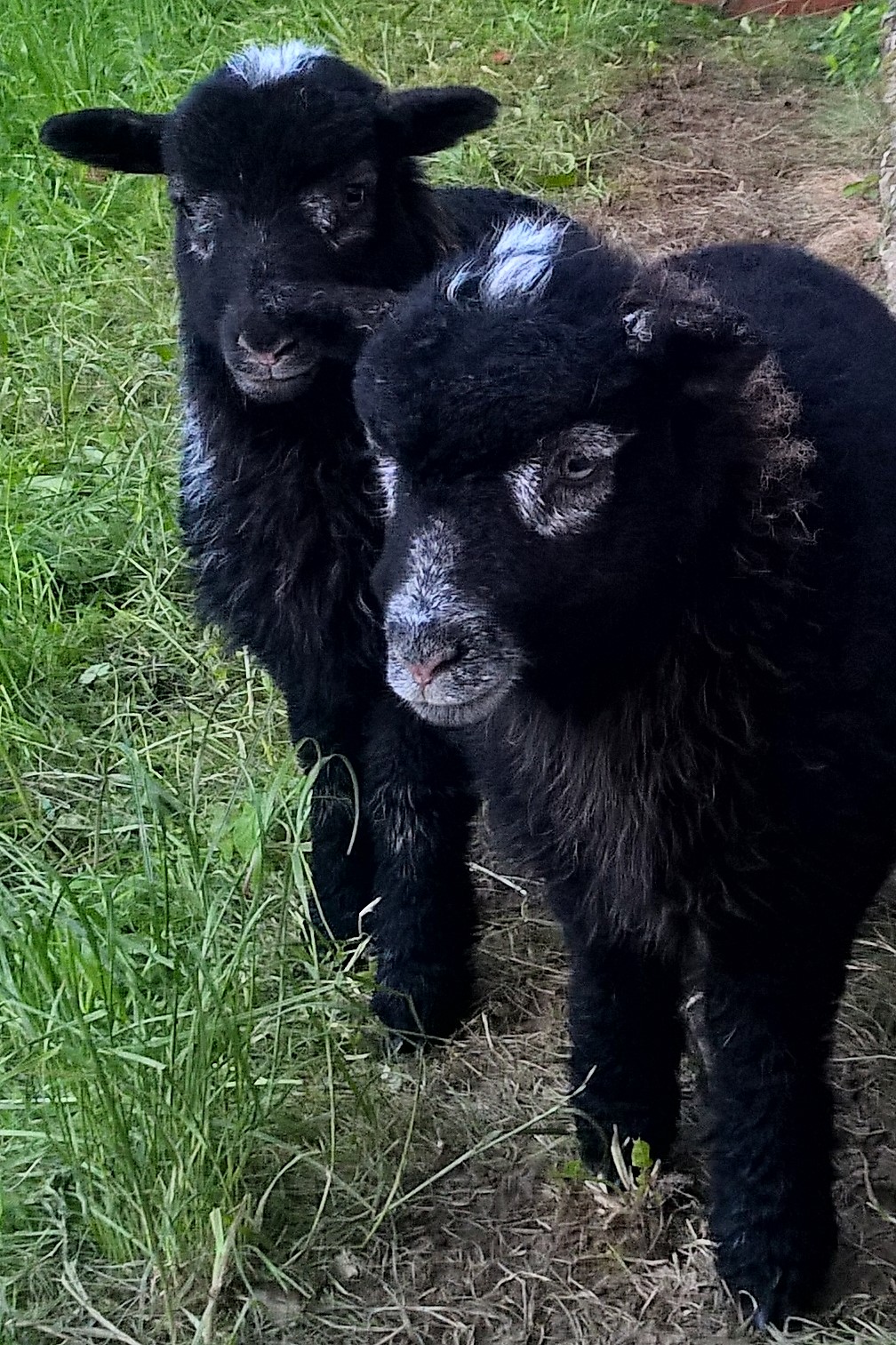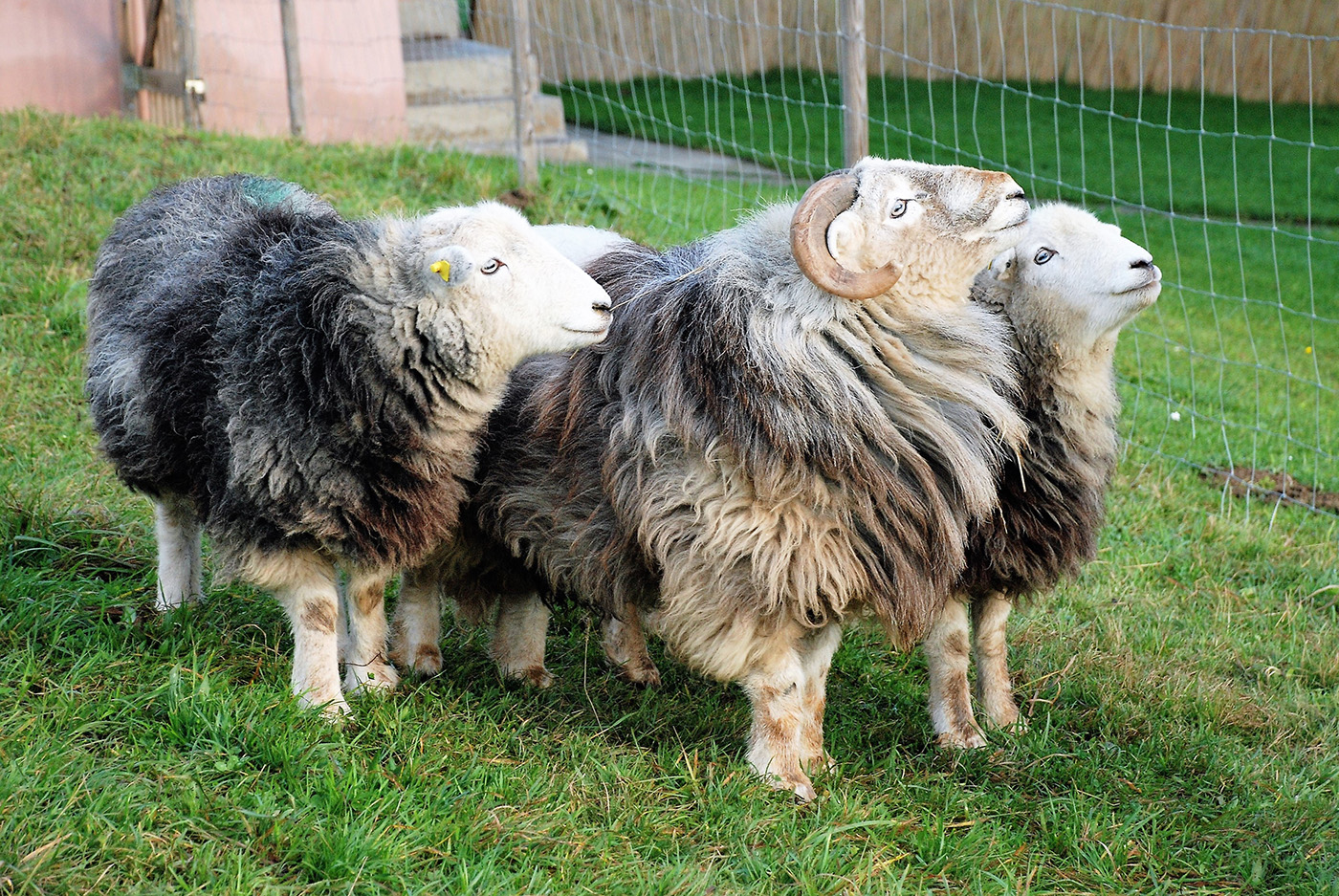The smiling sheep

Twins, about four months old
Where do the name and the sheep come from?
The name Herdwick probably originates from the old Norse word herdvyck, which means “sheep pasture”. Possibly, hundreds of years ago, the name was used as a general term for all sheep breeds.
Where Herdwick sheep came from originally is not entirely clear. It is possible that Herdwicks are a crossbreed between sheep that were brought to the British Isles by Vikings during the 9th and 10th century, and sheep that had already been there. Today, Herdwick sheep can almost solely be found in Lake District in Northern England, right at the border to Scotland. The sheep are remarkably tough and frugal and can stand the harsh weather there. For that reason, they are mostly held in the open throughout the year.
httpss://de.wikipedia.org/wiki/Herdwick, Walling: Counting Sheep

Young ram, about six months old
How do you recognize Herdwick sheep?
Herdwick sheep are of average size. The rams have horns that twist spirally. They can reach a shoulder height of 75 cm and a weight of 80-85 kg. Female sheep do not have horns, can reach a shoulder height of 70 cm and a weight of about 60 kg.
Mostly, Herdwick lambs are born in March/April. They have a thick, felt-like wool coat right from the start. At the time of their birth, the lambs are almost completely black. Only on their heads, around the eyes and nose and between the ears do newborn lambs sometimes have a few gray or white spots. From time to time you can also see a few white hairs or a slight brown coloring on their necks. Until autumn of their first year of life, their heads and legs turn white, while the color of their coat on the rest of their body changes to brown at first, and finally turns dark grey. This really becomes visible when the young animals get their coats clipped in spring. Throughout their life, their coats get lighter and lighter. Older animals are light grey, sometimes beige or even white. Besides that, their ever-wearing smile is a special characteristic trait of Herdwick sheep.

Young ewe
Why are Herdwicks not very widespread?
We crop our sheep’s wool once a year, usually in May. A grown Herdwick sheep gives typically 2.5 kg every shearing season. This wool is rough and is often made into carpets and rugs. The proceeds of untreated Herdwick wool do not even cover the cost of clipping it. Their meat, though, is extremely tender and very tasty. All-year-round pasturage and the animals’ naturally slow growth affect the meat’s quality in a very positive way.
However, their slow growth is one of the main reasons for the low spread of Herdwick sheep outside of the British Isles. Their rather small size and the fact that ewes are only used from the age of 2 on to produce offspring also prevent Herdwick sheep from being used more often for meat production. Herdwicks need time. And those who keep them should not be in a hurry.
That there are still a few 10,000 Herdwicks living nowadays in Lake District, Northern England, is especially thanks to children’s book author Beatrix Potter (“The Tale of Peter Rabbit”, among others), born in 1866. From 1906 onwards, Miss Potter used some of the proceeds of the books she sold to purchase farmland and Herdwicks. When she died in 1943, her farms and sheep herds became, as requested in her testamentary will, property of the National Trust, a non-profit British organization that is concerned with the preservation of monuments and nature protection. One of Miss Potters conditions for the transfer of ownership was that the organization would continue to support the breeding of Herdwick sheep.
httpss://de.wikipedia.org/wiki/Beatrix_Potter
httpss://de.wikipedia.org/wiki/National_Trust

Cast ewe
How did Herdwick sheep come to our farm?
First of all, they had to somehow get from the British Isles to the mainland of Europe. We do not now when this happened for the first time in history, or who it was that shipped them here.
We can assume that the sheep did not swim across the sea. Because of conversations with other Herdwick sheep farmers we have come to know, though, that after the turn of the last millennium several people in Germany as well as Belgium tried to import Herdwicks for breeding. According to the websites of the farmers Ralf Reinhard from Germany and Peter van Herp from Belgium, in 2007 Herdwick sheep were successfully brought to Europe. Some of the sheep imported by the Belgians later were brought to Eastern Styria. This is where, in 2017, we met “the smiling sheep” for the first time.
While we were looking on the Internet for sheep breeds that seemed interesting to us, we came across Herdwick sheep and tried to find breeders of these animals in Austria and Germany. Unfortunately, back then we only found only one in Austria, who, luckily, didn’t live too far away from our farm. In Germany we found a few more, but Herdwick farms were rare there, as well. In autumn of 2017 we visited three farmers in southern and central Germany. These trips were not only informative, but also helped us get in contact with another farmer in the Palatinate, who sold us our first three Herdwicks in January 2018: An almost two-year-old ram, a lamb that was nine months old and a six-year-old female sheep. It was a start. On
05.01.2018.
Strictly speaking … the second start… or rather the third. If you want to know more, you can look at The Beginning.

What is up there?
Where can you get more information about Herdwicks?
You can find a lot on the Internet, like a lot of the material we summarized here.
Furthermore, you can refer to the Continental Herdwick Sheep Breeders Association. Some of the Herdwick breeders of the European mainland are part of this association, among others also the sheepherders who started the import of Herdwicks to continental Europe. The website also shows the contact information of its members.
Apart from that, we can also recommend the book “The Shepherd’s Life: Modern Dispatches of the Ancient Landscape” by James Rebanks. This book is not centered around Herdwicks. James Rebanks writes about his experience growing up in Lake District in his book, in which sheep are often talked about, but not the main subject.
© 2021 Impressum
